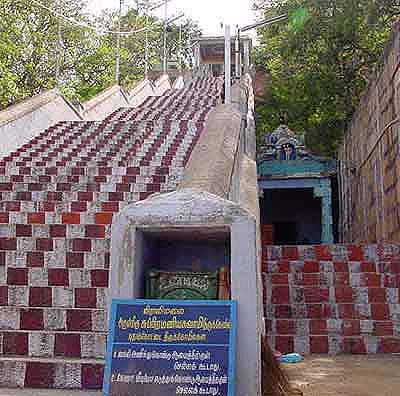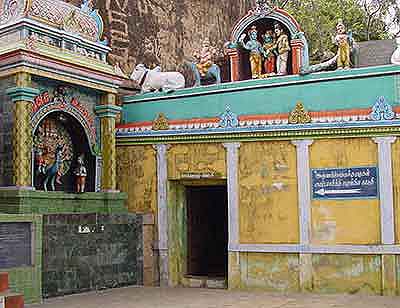
|
||||||||||||||||
|
| ||||||||||||||||
Viralimalai Murukan as described by Arunagirinathar
D. Chandrasekaran, I.A.S.The abodes of Lord Murukan are many and strewn not only across Tamil Nadu but all over the world in some or other. Lord Murukan is known to take abode on top of whatever sacred hill where He feels delighted. In Tamil, people call it Kudrutoradal. Of the many sacred hills of which He takes abode, six are considered to be particular to Lord Murukan as detailed in his work Tirumurukārrpatai. Apart from these six abodes, there are myriad of other obodes that are considered to be delightful to Lord Murukan. Viralimalai is one among them. Viralimalai is about twenty miles from Trichy on the highway leading to Madurai. This is a picturesque hill having sillhoute of brilliance of Lord's grace all around. Surrounding the hill, there is a small town always bustling with people doing their routine along with the devotees thronging for worship of Lord Murukan on top of the hill. Saint Arunagirnathar, who is considered to have been benedicted with the choicest grace of Lord Murukan, poured out 16,000 Tiruppukal hymns with such rhythms that no musician of very high calibore can dream of, sang these songs while visiting the famed places of Lord Murukan. He had an especially scintilating divine experience when he arrived at Viralimalai. Viralimalai was so special to Arunagirinathar that he composed sixteen Tiruppukal hymns in ecstasy as though he was performing sixteen upasaras stipulated in agamas. The Sivagamas stipulate that at the end of the ritual sixteen upasaras must be performed in praise of the Lord and describes Kota Vilaku, Natcitra Vilaku, fanning, etc. Arunagirinathar following the Sivagamas, performed these sixteen upasaras to Viralimalai Murukann but in Tamil hymns.
In a Tiruppukal hymn Arunagirinathar chooses to explain the modes and procedures of Sivayoga, how it is to be practiced, what the state of Sivayoga would be and how one has to identify with the Almighty, in categorical terms which no one in the past did. The succinct of this Tiruppukal projects very high horizon of metaphysical experience. However, this can be explained only by a guru (master) to his true disciple at the time when he found it ripe. I am not a man to be regarded as the highest calibre of guru, and hence I leave it to the readers to go through the text in Tiruppukal and see for themselves the highest ideals put into them. However, I will be failing in my duty if I do not explain one thing which is quite astonishing to whoever chances to read this. In the beautiful stanza starting with the words Arunagirinathar reveals that the boulders standing on the hills of Viralimalai are not the ordinary rocks made of sedimentary rocks, but that certain boulders at Viralimalai are agglomerations of the bodies of yogis who sat there in penance, for time unknown. Yogis of yore accosted Viralimalai aiming to reach the lotus feet of Lord Murukan. To this aim they would sit in penance there for centuries. The state of yoga called samādhi engulfed these yogis and in that state of supreme equilibrium, their bodies became rock like as the years rolled by. The astonishing fact is that people with the mundane sense of sight are not be able to see which rocks are yogis and which are ordinary rocks, whereas the peacocks strolling about on the sides of Viralimalai Hill know which is yogi and which is rock and select the yogis' rock only to dance upon. This fact is given by Arunagirinathar in the above stanza. It stirs pious emotions in devotees to ascend Viralimalai Hill, knowing not which rocks are yogis and which are ordinary rocks. In this extraordinary situation of yogis surrounding the hill, Arunagirinathar went to Viralimalai only to obtain upadesa (instruction) from Lord Murukan. He was a chosen devotee of Lord Murukan in that he came to Viralimalai not on his own but on an invitation from Lord Murukan, who appeared in his dreams and called him to visit Viralimalai. This reminds us of a similar anecdote in Periya Puranam where Appar was called upon by Lord Siva to visit Tiruvimūr. This has been the divine dispensation of the Almighty, by which Lord Siva or Lord Murukan called those selected devotees often to visiting certain chosen abodes for the purposes known only to them. We may understand from the above that Lord Murukan chose this place, namely Viralimalai, to shower His choicest blessing on his select devotee Arunagirinathar. In this way He revealed that Viralimalai is a special place abounding with effulgent grace. Therefore, it thrills anybody with devotion who visit Viralimalai.
Arunagirinathar, on his advent to Viralimalai, experienced more of bliss than in any other place. His experience loomed manifold with the subtle presence of yogis of yore all around him. He started yelling out in ecstasy that Lord Murukan chose him to do the service to Him and made him a servant of long lineage. In another Tiruppukal hymn, Arunagirinathar makes known that Lord Murukan of Viralimalai emerged from the sanctum sanctorum and appeared before him only to hear the Tiruppukal song sung by him. Arunagirinathar in another hymn speaks of Viralimalai Murukan as the one who incarnated as Jñānasambandhar. This has a specific meaning that Jñanasambandhar and Lord Murukan, as theory advanced by people of wisdom goes, are one and the same Sambandar is His incarnation. This may at first sight seem to be contradictory to the concept advanced by Arunagirinathar himself in another stanza of his own work known as Kandar Anubhuti where he promulgates that Lord Murukan as the Almighty does not take birth nor die. Whereas in the above stanza of Viralimalai Tiruppukal, Arunagirinathar says that Sambandar is nothing but the incarnation of Viralimalai Murukan.
There is a postulation in the Saiva Siddhanantha that there are four categories of salvation, namely svaloka, samīpa, svarūpa and sayuciya. Those who perform rituals of sarya pātha in the highest calibre attain svaloka pātha by which they come to the precincts of the Almighty. Those who perform the rituals of kriya pātha to the full extent become close confidents of Almighty which is known as samīpa. Those who perform yoga to its fullest extent become one to resemble God in rūpa (i.e. appearance), which is called svarūpa. Those who perform worship in jñāna pātha to its fullest extent attain complete salvation in its fullest meaning, which is called sayuciya. There are hundreds of millions of bhaktas who have performed yoga to its fullest extend and came to resemble Lord Murukan, of which Jnanasambandhar was one who, having performed yoga with Lord Murukan in his thoughts, had come to appear in the form of Lord Murukan attaining the svarūpa stage. Hence in appearance Lord Murukan and Jnanasambandhar would seem to be one and the same. It is therefore told by ancient sages that Jnanasambandhar is none other than Lord Murukan. This theory has been taken in by Arunagirinathar and explained in Viralimalai Tiruppukal. Thus Lord Murukan is praised by Arunagirinathar in sixteen Viralimalai Tiruppukal hymns giving out the full account of bhakti puranic episodes and geographical descriptions par excellance. With all humility and as a slave to Lord Murukan, I must confess that I am always greateful to my Lord. I have fathomless love and unbounded affection for Lord Murukan of Viralimalai. I had the divine opportunity of performing the Kumbhabhishekam in the year 1994 for Viralimalai Murukan Temple after a gap of many years when I was District Collector of Pudukkottai District. I take this opportunity to invite all readers to visit Viralimalai at least once in your lifetime so that you can experience the dazzling, delighting, thrilling and titilating grace of Lord Murukan. See also the Viralimalai Murugan Temple home page |
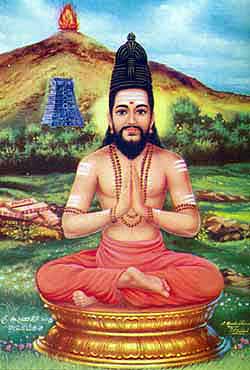
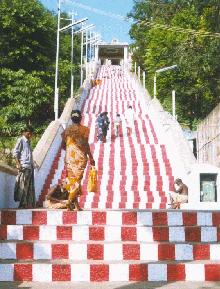
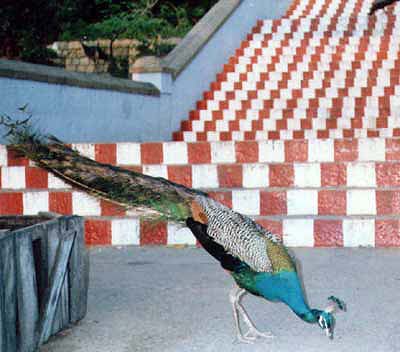

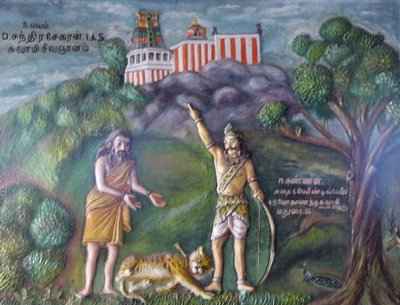
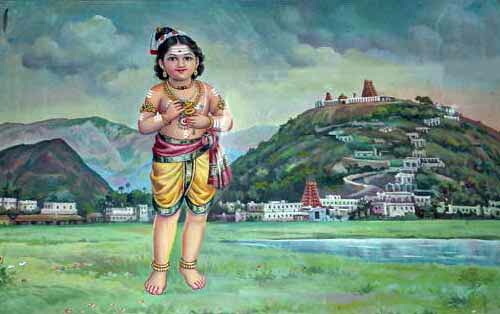 This Monthj=1>
This Monthj=1>